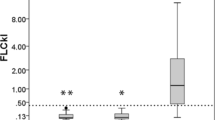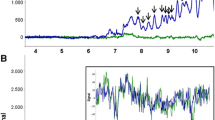Abstract
The analysis of paired cerebrospinal fluid (CSF) and serum samples with isolectric focusing (IEF) can yield different patterns which can be of aid in the differential diagnosis of central nervous system (CNS) disorders. Rarely, a single CSF-restricted IgG band, which is not included within these patterns, can be detected in association with inflammatory disorders, multiple sclerosis (MS) above all. However, the diagnostic meaning of this abnormality is still uncertain. The main aim of our multicenter study was to establish the frequency and disease associations of single CSF IgG bands. Differences in the CSF profiles between MS and other diseases, and the follow-up patterns were also evaluated. Medical records of patients who underwent CSF analysis, which included IEF, over a 11.5-year period were retrospectively scrutinized at the participating centers, which used similar IEF techniques. One hundred and fifty-one of 9422 CSF reports (1.6%) showed single CSF-restricted IgG bands. Of the 129 patients with a definite diagnosis, 58.2% had CNS inflammatory-demyelinating diseases (the most frequent being MS: 21.7%), 6.2% tumours, 5.4% inflammatory peripheral nervous system diseases and 30.2% miscellaneous diseases. At follow-up, 3 out of the 10 patients with a repeated CSF analysis had developed an oligoclonal band pattern. Our findings indicate that single CSF IgG bands tend to associate with diseases characterized by the involvement of intrathecal humoral immune responses, and strongly support the notion that this abnormality should be regularly reported, thus alerting clinicians of possible inflammatory disorders of the CNS.

Similar content being viewed by others
References
Gastaldi M, Zardini E, Franciotta D (2017) An update on the use of cerebrospinal fluid analysis as a diagnostic tool in multiple sclerosis. Expert Rev Mol Diagn 17:31–46. doi:10.1080/14737159.2017.1262260
Freedman MS, Thompson EJ, Deisenhammer F et al (2005) Recommended standard of cerebrospinal fluid analysis in the diagnosis of multiple sclerosis: a consensus statement. Arch Neurol 62:865–870. doi:10.1001/archneur.62.6.865
Andersson M, Alvarez-Cermeño J, Bernardi G et al (1994) Cerebrospinal fluid in the diagnosis of multiple sclerosis: a consensus report. J Neurol Neurosurg Psychiatry 57:897–902
Ben-Hur T, Abramsky O, River Y (1996) The clinical significance of a single abnormal immunoglobulin band in cerebrospinal fluid electrophoresis. J Neurol Sci 136:159–161
Davies G, Keir G, Thompson EJ, Giovannoni G (2003) The clinical significance of an intrathecal monoclonal immunoglobulin band: a follow-up study. Neurology 60:1163–1166. doi:10.1212/WNL.62.7.1237
Franciotta D, Zardini E, Lolli F et al (2004) The clinical significance of an intrathecal monoclonal immunoglobulin band: a follow-up study. Neurology 62:675–676
Franciotta D, Bergamaschi R, Amato MP et al (2005) Clinical correlations of CSF single IgG bands. J Neurol 252:1274–1275. doi:10.1007/s00415-005-0820-1
McCombe PA, Brown NN, Barr AE, Parkin L (1991) Monoclonal immunoglobulin bands in the cerebrospinal fluid. Aust N Z J Med 21:227–229
Bass BH, Armstrong H, Weinshenker B et al (1988) Interpretation of single band patterns in CSF protein electrophoresis. Can J Neurol Sci 15:20–22
Link H, Kostulas V (1983) Utility of isoelectric focusing of cerebrospinal fluid and serum on agarose evaluated for neurological patients. Clin Chem 29:810–815
Axelsson M, Mattsson N, Malmeström C et al (2013) The influence of disease duration, clinical course, and immunosuppressive therapy on the synthesis of intrathecal oligoclonal IgG bands in multiple sclerosis. J Neuroimmunol 264:100–105. doi:10.1016/j.jneuroim.2013.09.003
Mattson DH, Roos RP, Arnason BG (1981) Comparison of agar gel electrophoresis and isoelectric focusing in multiple sclerosis and subacute sclerosing panencephalitis. Ann Neurol 9:34–41. doi:10.1002/ana.410090107
Thompson EJ, Kaufmann P, Rudge P (1983) Sequential changes in oligoclonal patterns during the course of multiple sclerosis. J Neurol Neurosurg Psychiatry 46:547–550
Trip SA, Wroe SJ, Davies G, Giovannoni G (2003) Primary CNS mantle cell lymphoma associated with an isolated CSF monoclonal IgG band. Eur Neurol 49:187–188. doi:10.1159/000069080
Ruiz P, Moezzi M, Chamizo W et al (1992) Central nervous system expression of a monoclonal paraprotein in a chronic lymphocytic leukemia patient. Acta Haematol 88:37–40
Kamm C, Zettl UK (2012) Autoimmune disorders affecting both the central and peripheral nervous system. Autoimmun Rev 11:196–202. doi:10.1016/j.autrev.2011.05.012
Dalakas MC, Houff SA, Engel WK et al (1980) CSF “monoclonal” bands in chronic relapsing polyneuropathy. Neurology 30:864–867
Roström B, Link B (1981) Oligoclonal immunoglobulins in cerebrospinal fluid in acute cerebrovascular disease. Neurology 31:590–596
Miller JR, Burke AM, Bever CT (1983) Occurrence of oligoclonal bands in multiple sclerosis and other CNS diseases. Ann Neurol 13:53–58. doi:10.1002/ana.410130112
Janssen JC, Godbolt AK, Ioannidis P et al (2004) The prevalence of oligoclonal bands in the CSF of patients with primary neurodegenerative dementia. J Neurol 251:184–188. doi:10.1007/s00415-004-0296-4
Author information
Authors and Affiliations
Consortia
Corresponding author
Ethics declarations
Conflicts of interest
The authors declare that they have no conflict of interest.
Ethical standards statement
This study was performed in accordance with the ethical standards statement.
Funding
This research did not receive any specific grant from funding agencies in the public, commercial, or not-for-profit sectors.
Rights and permissions
About this article
Cite this article
Ferraro, D., Franciotta, D., Bedin, R. et al. A multicenter study on the diagnostic significance of a single cerebrospinal fluid IgG band. J Neurol 264, 973–978 (2017). https://doi.org/10.1007/s00415-017-8480-5
Received:
Accepted:
Published:
Issue Date:
DOI: https://doi.org/10.1007/s00415-017-8480-5




